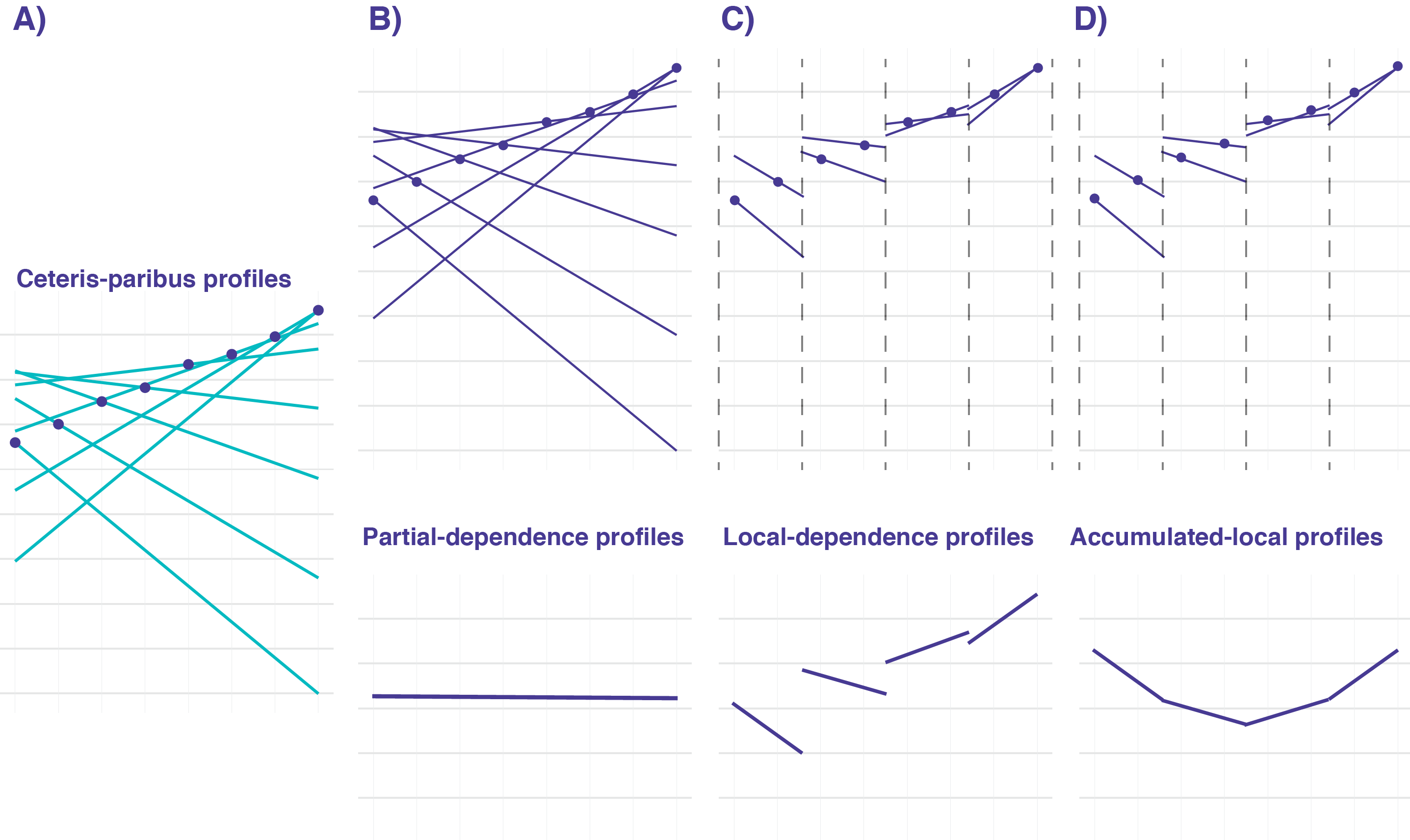18 Local-dependence and Accumulated-local Profiles
18.1 Introduction
Partial-dependence (PD) profiles, introduced in the previous chapter, are easy to explain and interpret, especially given their estimation as the mean of ceteris-paribus (CP) profiles. However, as it was mentioned in Section 17.5, the profiles may be misleading if, for instance, explanatory variables are correlated. In many applications, this is the case. For example, in the apartment-prices dataset (see Section 4.4), one can expect that variables surface and number of rooms may be positively correlated, because apartments with a larger number of rooms usually also have a larger surface. Thus, in ceteris-paribus profiles, it is not realistic to consider, for instance, an apartment with five rooms and a surface of 20 square meters. Similarly, in the Titanic dataset, a positive association can be expected for the values of variables fare and class, as tickets in the higher classes are more expensive than in the lower classes.
In this chapter, we present accumulated-local profiles that address this issue. As they are related to local-dependence profiles, we introduce the latter first. Both approaches were proposed by Apley (2018).
18.2 Intuition
Let us consider the following simple linear model with two explanatory variables:
\[\begin{equation} Y = X^1 + X^2 + \varepsilon = f(X^1, X^2) + \varepsilon, \tag{18.1} \end{equation}\]
where \(\varepsilon \sim N(0,0.1^2)\).
For this model, the effect of \(X^1\) for any value of \(X^2\) is linear, i.e., it can be described by a straight line with the intercept equal to 0 and the slope equal to 1.
Assume that observations of explanatory variables \(X^1\) and \(X^2\) are uniformly distributed over the unit square, as illustrated in the left-hand-side panel of Figure 18.1 for a set of 1000 observations. The right-hand-side panel of Figure 18.1 presents the scatter plot of the observed values of \(Y\) in function of \(X^1\). The plot for \(X^2\) is, essentially, the same and we do not show it.
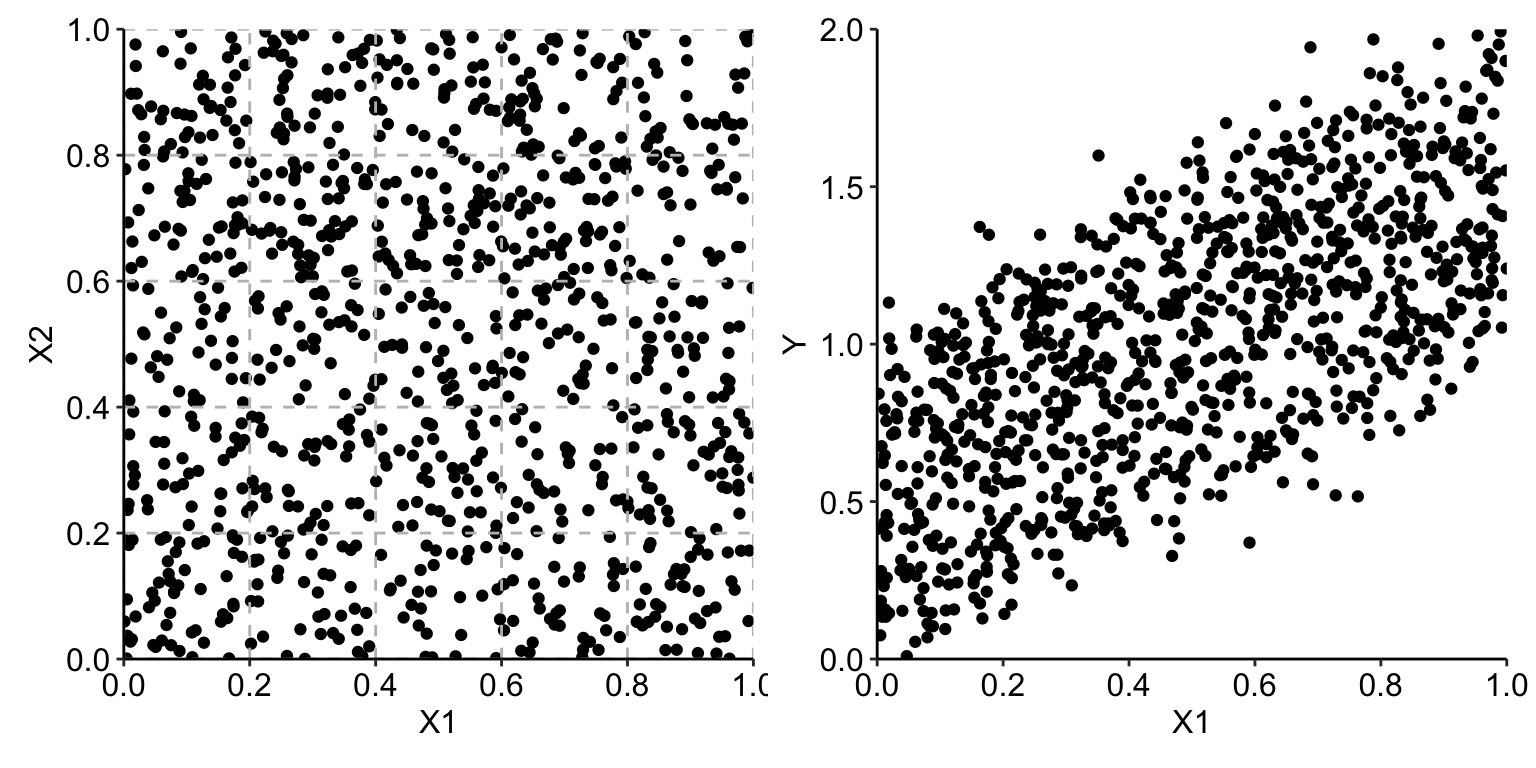
Figure 18.1: Observations of two explanatory variables uniformly distributed over the unit square (left-hand-side panel) and the scatter plot of the observed values of the dependent variable \(Y\) in function of \(X^1\) (right-hand-side panel).
In view of the plot shown in the right-hand-side panel of Figure 18.1, we could consider using a simple linear model with \(X^1\) and \(X^2\) as explanatory variables. Assume, however, that we would like to analyze the data without postulating any particular parametric form of the effect of the variables. A naïve way would be to split the observed range of each of the two variables into, for instance, five intervals (as illustrated in the left-hand-side panel of Figure 18.1), and estimate the means of observed values of \(Y\) for the resulting 25 groups of observations. Table 18.1 presents the sample means (with rows and columns defined by the ranges of possible values of, respectively, \(X^1\) and \(X^2\)).
| (0,0.2] | (0.2,0.4] | (0.4,0.6] | (0.6,0.8] | (0.8,1] | |
|---|---|---|---|---|---|
| (0,0.2] | 0.19 | 0.42 | 0.63 | 0.80 | 0.99 |
| (0.2,0.4] | 0.39 | 0.59 | 0.81 | 1.01 | 1.19 |
| (0.4,0.6] | 0.59 | 0.81 | 0.98 | 1.20 | 1.44 |
| (0.6,0.8] | 0.76 | 1.00 | 1.20 | 1.40 | 1.58 |
| (0.8,1] | 1.01 | 1.22 | 1.38 | 1.58 | 1.77 |
Table 18.2 presents the number of observations for each of the sample means from Table 18.1.
| (0,0.2] | (0.2,0.4] | (0.4,0.6] | (0.6,0.8] | (0.8,1] | total | |
|---|---|---|---|---|---|---|
| (0,0.2] | 51 | 39 | 31 | 43 | 43 | 207 |
| (0.2,0.4] | 39 | 40 | 35 | 53 | 42 | 209 |
| (0.4,0.6] | 28 | 42 | 35 | 49 | 40 | 194 |
| (0.6,0.8] | 37 | 30 | 36 | 55 | 45 | 203 |
| (0.8,1] | 43 | 46 | 36 | 28 | 34 | 187 |
| total | 198 | 197 | 173 | 228 | 204 | 1000 |
By using this simple approach, we can compute the PD profile for \(X^1\). Consider \(X^1=z\). To apply the estimator defined in (17.2), we need the predicted values \(\hat{f}(z,x^2_i)\) for any observed value of \(x^2_i \in [0,1]\). As our observations are uncorrelated and fill-in the unit-square, we can use the suitable mean values for that purpose. In particular, for \(z \in [0,0.2]\), we get
\[\begin{align} \hat g_{PD}^{1}(z) &= \frac{1}{1000}\sum_{i}\hat{f}(z,x^2_i) = \nonumber \\ &= (198\times 0.19 + 197\times 0.42 + 173\times 0.63 + \nonumber\\ & \ \ \ \ \ 228\times 0.80 + 204\times 1.00)/1000 = 0.6. \nonumber \tag{18.2} \end{align}\]
By following the same principle, for \(z \in (0.2,0.4]\), \((0.4,0.6]\), \((0.6,0.8]\), and \((0.8,1]\) we get the values of 0.8, 1, 1.2, and 1.4, respectively. Thus, overall, we obtain a piecewise-constant profile with values that capture the (correct) linear effect of \(X^1\) in model (18.1). In fact, by using, for instance, midpoints of the intervals for \(z\), i.e., 0.1, 0.3, 0.5, 0.7, and 0.9, we could describe the profile by the linear function \(0.5+z\).
Assume now that we are given the data only from the regions on the diagonal of the unit square, as illustrated in the left-hand-side panel of Figure 18.2. In that case, the observed values of \(X^1\) and \(X^2\) are strongly correlated, with the estimated value of Pearson’s correlation coefficient equal to 0.96. The right-hand-side panel of Figure 18.2 presents the scatter plot of the observed values of \(Y\) in the function of \(X^1\).

Figure 18.2: Correlated observations of two explanatory variables (left-hand-side panel) and the scatter plot of the observed values of the dependent variable \(Y\) in the function of \(X^1\) (right-hand-side panel).
Now, the “naïve” modelling approach would amount to using only five sample means, as in the table below.
| (0,0.2] | (0.2,0.4] | (0.4,0.6] | (0.6,0.8] | (0.8,1] | |
|---|---|---|---|---|---|
| (0,0.2] | 0.19 | NA | NA | NA | NA |
| (0.2,0.4] | NA | 0.59 | NA | NA | NA |
| (0.4,0.6] | NA | NA | 0.98 | NA | NA |
| (0.6,0.8] | NA | NA | NA | 1.4 | NA |
| (0.8,1] | NA | NA | NA | NA | 1.77 |
When computing the PD profile for \(X^1\), we now encounter the issue related to the fact that, for instance, for \(z \in [0,0.2]\), we have not got any observations and, hence, any sample mean for \(x^2_i>0.2\). To overcome this issue, we could extrapolate the predictions (i.e., mean values) obtained for other intervals of \(z\). That is, we could assume that, for \(x^2_i \in (0.2,0.4]\), the prediction is equal to 0.59, for \(x^2_i \in (0.4,0.6]\) it is equal to 0.98, and so on. This leads to the following value of the PD profile for \(z \in [0,0.2]\):
\[\begin{align} \hat g_{PD}^{1}(z) &= \frac{1}{51 + 40 + 35 + 55 + 34}\sum_{i}\hat{f}(z,x^2_i) = \nonumber \\ &= \frac{1}{215}(51\times0.19 + 40\times0.59 + 35\times0.98 + \nonumber \\ & \ \ \ \ \ 55\times1.40 + 34\times1.77)=0.95. \end{align}\]
This is a larger value than 0.6 computed in (18.2) for the uncorrelated data. The reason is the extrapolation: for instance, for \(z \in [0,0.2]\) and \(x^2_i \in (0.6,0.8]\), we use 1.40 as the predicted value of \(Y\). However, Table 18.1 indicates that the sample mean for those observations is equal to 0.80.
In fact, by using the same extrapolation principle, we get \(\hat g_{PD}^{1}(z) = 0.95\) also for \(z \in (0.2,0.4]\), \((0.4,0.6]\), \((0.6,0.8]\), and \((0.8,1]\). Thus, the obtained profile indicates no effect of \(X^1\), which is clearly a wrong conclusion.
While the modelling approach presented in the example above may seem to be simplistic, it does illustrate the issue that would also appear for other flexible modelling methods like, for instance, regression trees. In particular, the left-hand-side panel of Figure 18.3 presents a regression tree fitted to the data shown in Figure 18.2 by using function tree() from the R package tree. The right-hand-side panel of Figure 18.3 presents the corresponding split of the observations. According to the model, the predicted value of \(Y\) for the observations in the region \(x^1 \in [0,0.2]\) and \(x^2 \in [0.8,1]\) would be equal to 1.74. This extrapolation implies a substantial overestimation, as the true expected value of \(Y\) in the region is equal to 1. Note that the latter is well estimated by the sample mean equal to 0.99 (see Table 18.1) in the case of the uncorrelated data shown in Figure 18.1.
The PD profile for \(X^1\) for the regression tree would be equal to 0.2, 0.8, and 1.5 for \(z \in [0,0.2]\), \((0.2,0.6]\), and \((0.6,1]\), respectively. It does show an effect of \(X^1\), but if we used midpoints of the intervals for \(z\), i.e., 0.1, 0.4, and 0.8, we could (approximately) describe the profile by the linear function \(2z\), i.e., with a slope larger than (the true value of) 1.
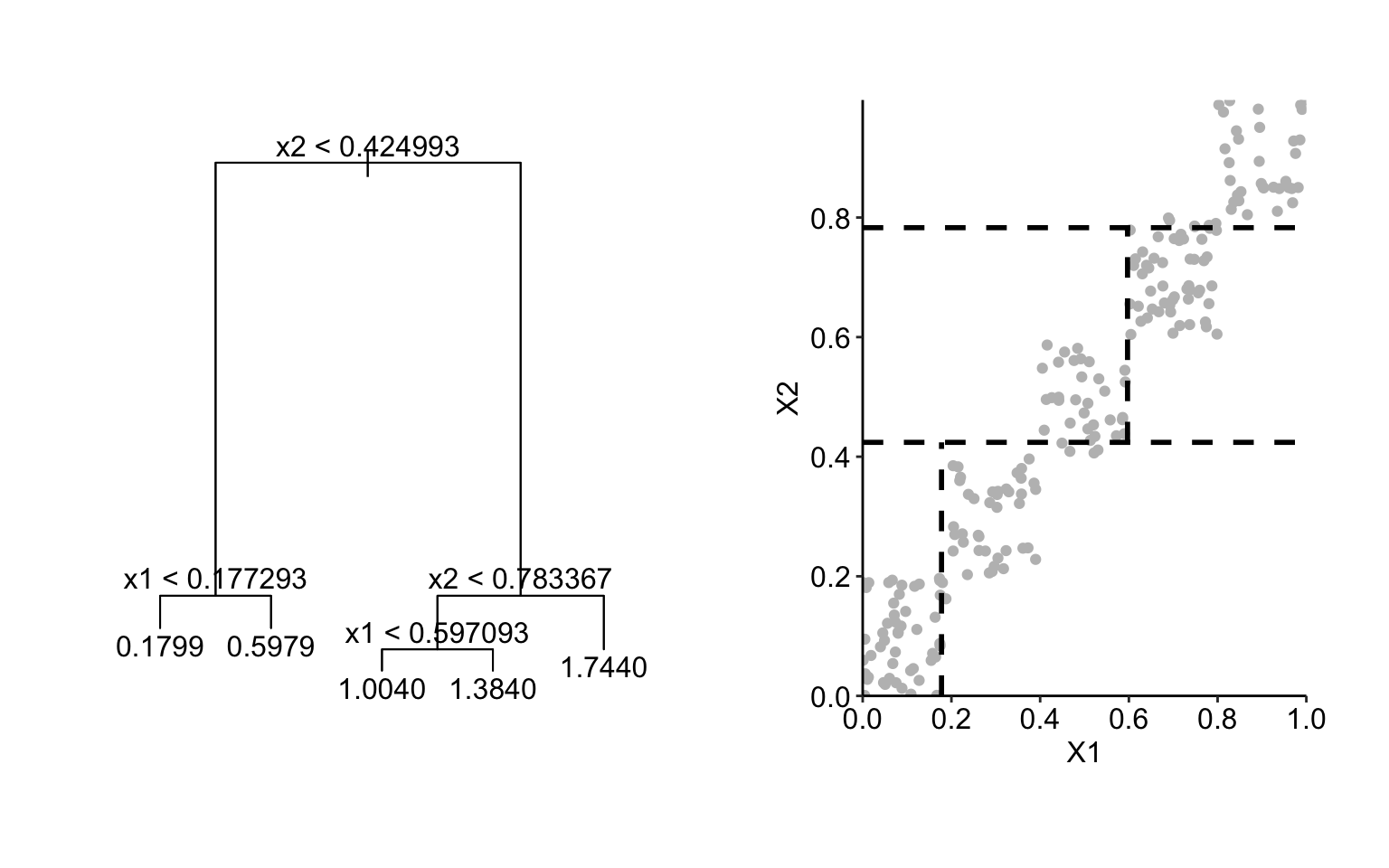
Figure 18.3: Results of fitting of a regression tree to the data shown in Figure 18.2 (left-hand-side panel) and the corresponding split of the observations of the two explanatory variables (right-hand-side panel).
The issue stems from the fact that, in the definition (17.1) of the PD profile, the expected value of model predictions is computed by using the marginal distribution of \(X^2\), which disregards the value of \(X^1\). Clearly, this is an issue when the explanatory variables are correlated. This observation suggests a modification: instead of the marginal distribution, one might use the conditional distribution of \(X^2\) given \(X^1\), because it reflects the association between the two variables. The modification leads to the definition of an LD profile.
It turns out, however, that the modification does not fully address the issue of correlated explanatory variables. As argued by Apley and Zhu (2020), if an explanatory variable is correlated with some other variables, the LD profile for the variable will still capture the effect of the other variables. This is because the profile is obtained by marginalizing over (in fact, ignoring) the remaining variables in the model, which results in an effect similar to the “omitted variable” bias in linear regression. Thus, in this respect, LD profiles share the same limitation as PD profiles. To address the limitation, Apley and Zhu (2020) proposed the concept of local-dependence effects and accumulated-local (AL) profiles.
18.3 Method
18.3.1 Local-dependence profile
Local-dependence (LD) profile for model \(f()\) and variable \(X^j\) is defined as follows:
\[\begin{equation} g_{LD}^{f, j}(z) = E_{\underline{X}^{-j}|X^j=z}\left\{f\left(\underline{X}^{j|=z}\right)\right\}. \tag{18.3} \end{equation}\]
Thus, it is the expected value of the model predictions over the conditional distribution of \(\underline{X}^{-j}\) given \(X^j=z\), i.e., over the joint distribution of all explanatory variables other than \(X^j\) conditional on the value of the latter variable set to \(z\). Or, in other words, it is the expected value of the CP profiles for \(X^j\), defined in (10.1), over the conditional distribution of \(\underline{X}^{-j} | X^j = z\).
As proposed by Apley and Zhu (2020), LD profile can be estimated as follows:
\[\begin{equation} \hat g_{LD}^{j}(z) = \frac{1}{|N_j|} \sum_{k\in N_j} f\left(\underline{x}_k^{j| = z}\right), \tag{18.4} \end{equation}\]
where \(N_j\) is the set of observations with the value of \(X^j\) “close” to \(z\) that is used to estimate the conditional distribution of \(\underline{X}^{-j}|X^j=z\).
Note that, in general, the estimator given in (18.4) is neither smooth nor continuous at boundaries between subsets \(N_j\). A smooth estimator for \(g_{LD}^{f,j}(z)\) can be defined as follows:
\[\begin{equation} \tilde g_{LD}^{j}(z) = \frac{1}{\sum_k w_{k}(z)} \sum_{i = 1}^n w_i(z) f\left(\underline{x}_i^{j| = z}\right), \tag{18.5} \end{equation}\]
where weights \(w_i(z)\) capture the distance between \(z\) and \(x_i^j\). In particular, for a categorical variable, we may just use the indicator function \(w_i(z) = 1_{z = x^j_i}\), while for a continuous variable we may use the Gaussian kernel:
\[\begin{equation} w_i(z) = \phi(z - x_i^j, 0, s), \tag{18.6} \end{equation}\]
where \(\phi(y,0,s)\) is the density of a normal distribution with mean 0 and standard deviation \(s\). Note that \(s\) plays the role of a smoothing factor.
As already mentioned in Section 18.2, if an explanatory variable is correlated with some other variables, the LD profile for the variable will capture the effect of all of the variables. For instance, consider model (18.1). Assume that \(X^1\) has a uniform distribution on \([0,1]\) and that \(X^1=X^2\), i.e., explanatory variables are perfectly correlated. In that case, the LD profile for \(X^1\) is given by
\[ g_{LD}^{1}(z) = E_{X^2|X^1=z}(z+X^2) = z + E_{X^2|X^1=z}(X^2) = 2z. \] Hence, it suggests an effect of \(X^1\) twice larger than the correct one.
To address the limitation, AL profiles can be used. We present them in the next section.
18.3.2 Accumulated-local profile
Consider model \(f()\) and define
\[ q^j(\underline{u})=\left\{ \frac{\partial f(\underline{x})}{\partial x^j} \right\}_{\underline{x}=\underline{u}}. \] Accumulated-local (AL) profile for model \(f()\) and variable \(X^j\) is defined as follows:
\[\begin{equation} g_{AL}^{j}(z) = \int_{z_0}^z \left[E_{\underline{X}^{-j}|X^j=v}\left\{ q^j(\underline{X}^{j|=v}) \right\}\right] dv + c, \tag{18.7} \end{equation}\]
where \(z_0\) is a value close to the lower bound of the effective support of the distribution of \(X^j\) and \(c\) is a constant, usually selected so that \(E_{X^j}\left\{g_{AL}^{j}(X^j)\right\} = 0\).
To interpret (18.7), note that \(q^j(\underline{x}^{j|=v})\) describes the local effect (change) of the model due to \(X^j\). Or, to put it in other words, \(q^j(\underline{x}^{j|=v})\) describes how much the CP profile for \(X^j\) changes at \((x^1,\ldots,x^{j-1},v,x^{j+1},\ldots,x^p)\). This effect (change) is averaged over the “relevant” (according to the conditional distribution of \(\underline{X}^{-j}|X^j\)) values of \(\underline{x}^{-j}\) and, subsequently, accumulated (integrated) over values of \(v\) up to \(z\). As argued by Apley and Zhu (2020), the averaging of the local effects allows avoiding the issue, present in the PD and LD profiles, of capturing the effect of other variables in the profile for a particular variable in additive models (without interactions). To see this, one can consider the approximation
\[ f(\underline{x}^{j|=v+dv})-f(\underline{x}^{j|=v}) \approx q^j(\underline{x}^{j|=v})dv, \]
and note that the difference \(f(\underline{x}^{j|=v+dv})-f(\underline{v}^{j|=v})\), for a model without interaction, effectively removes the effect of all variables other than \(X^j\).
For example, consider model (18.1). In that case, \(f(x^1,x^2)=x^1+x^2\) and \(q^1(\underline{u}) = 1\). Thus,
\[ f(u+du,x_2)-f(u,x_2) = (u + du + x^2) - (u + x^2) = du = q^1(u)du. \]
Consequently, irrespective of the joint distribution of \(X^1\) and \(X^2\) and upon setting \(c=z_0\), we get \[ g_{AL}^{1}(z) = \int_{z_0}^z \left\{E_{{X}^{2}|X^1=v}(1)\right\} dv + z_0 = z. \]
To estimate an AL profile, one replaces the integral in (18.7) by a summation and the derivative with a finite difference (Apley and Zhu 2020). In particular, consider a partition of the range of observed values \(x_{i}^j\) of variable \(X^j\) into \(K\) intervals \(N_j(k)=\left(z_{k-1}^j,z_k^j\right]\) (\(k=1,\ldots,K\)). Note that \(z_0^j\) can be chosen just below \(\min(x_1^j,\ldots,x_N^j)\) and \(z_K^j=\max(x_1^j,\ldots,x_N^j)\). Let \(n_j(k)\) denote the number of observations \(x_i^j\) falling into \(N_j(k)\), with \(\sum_{k=1}^K n_j(k)=n\). An estimator of the AL profile for variable \(X^j\) can then be constructed as follows:
\[\begin{equation} \widehat{g}_{AL}^{j}(z) = \sum_{k=1}^{k_j(z)} \frac{1}{n_j(k)} \sum_{i: x_i^j \in N_j(k)} \left\{ f\left(\underline{x}_i^{j| = z_k^j}\right) - f\left(\underline{x}_i^{j| = z_{k-1}^j}\right) \right\} - \hat{c}, \tag{18.8} \end{equation}\]
where \(k_j(z)\) is the index of interval \(N_j(k)\) in which \(z\) falls, i.e., \(z \in N_j\{k_j(z)\}\), and \(\hat{c}\) is selected so that \(\sum_{i=1}^n \widehat{g}_{AL}^{f,j}(x_i^j)=0\).
To interpret (18.8), note that difference \(f\left(\underline{x}_i^{j| = z_k^j}\right) - f\left(\underline{x}_i^{j| = z_{k-1}^j}\right)\) corresponds to the difference of the CP profile for the \(i\)-th observation at the limits of interval \(N_j(k)\). These differences are then averaged across all observations for which the observed value of \(X^j\) falls into the interval and are then accumulated.
Note that, in general, \(\widehat{g}_{AL}^{f,j}(z)\) is not smooth at the boundaries of intervals \(N_j(k)\). A smooth estimate can obtained as follows:
\[\begin{equation} \widetilde{g}_{AL}^{j}(z) = \sum_{k=1}^K \left[ \frac{1}{\sum_{l} w_l(z_k)} \sum_{i=1}^N w_{i}(z_k) \left\{f\left(\underline{x}_i^{j| = z_k}\right) - f\left(\underline{x}_i^{j| = z_k - \Delta}\right)\right\}\right] - \hat{c}, \tag{18.9} \end{equation}\]
where points \(z_k\) (\(k=0, \ldots, K\)) form a uniform grid covering the interval \((z_0,z)\) with step \(\Delta = (z-z_0)/K\), and weight \(w_i(z_k)\) captures the distance between point \(z_k\) and observation \(x_i^j\). In particular, we may use similar weights as in case of (18.5).
18.4 Example: apartment-prices data
In this section, we use PD, LD, and AL profiles to evaluate performance of the random forest model apartments_rf (see Section 4.5.2) for the apartment-prices dataset (see Section 4.4). Recall that the goal is to predict the price per square meter of an apartment. In our illustration, we focus on two explanatory variables, surface and number of rooms, as they are correlated (see Figure 4.9).
Figure 18.5 shows the three types of profiles for both variables estimated according to formulas (17.2), (18.5), and (18.9). As we can see from the plots, the profiles calculated with different methods are different. The LD profiles are steeper than the PD profiles. This is because, for instance, the effect of surface includes the effect of other correlated variables, including number of rooms. The AL profile eliminates the effect of correlated variables. Since the AL and PD profiles are parallel to each other, they suggest that the model is additive for these two explanatory variables.
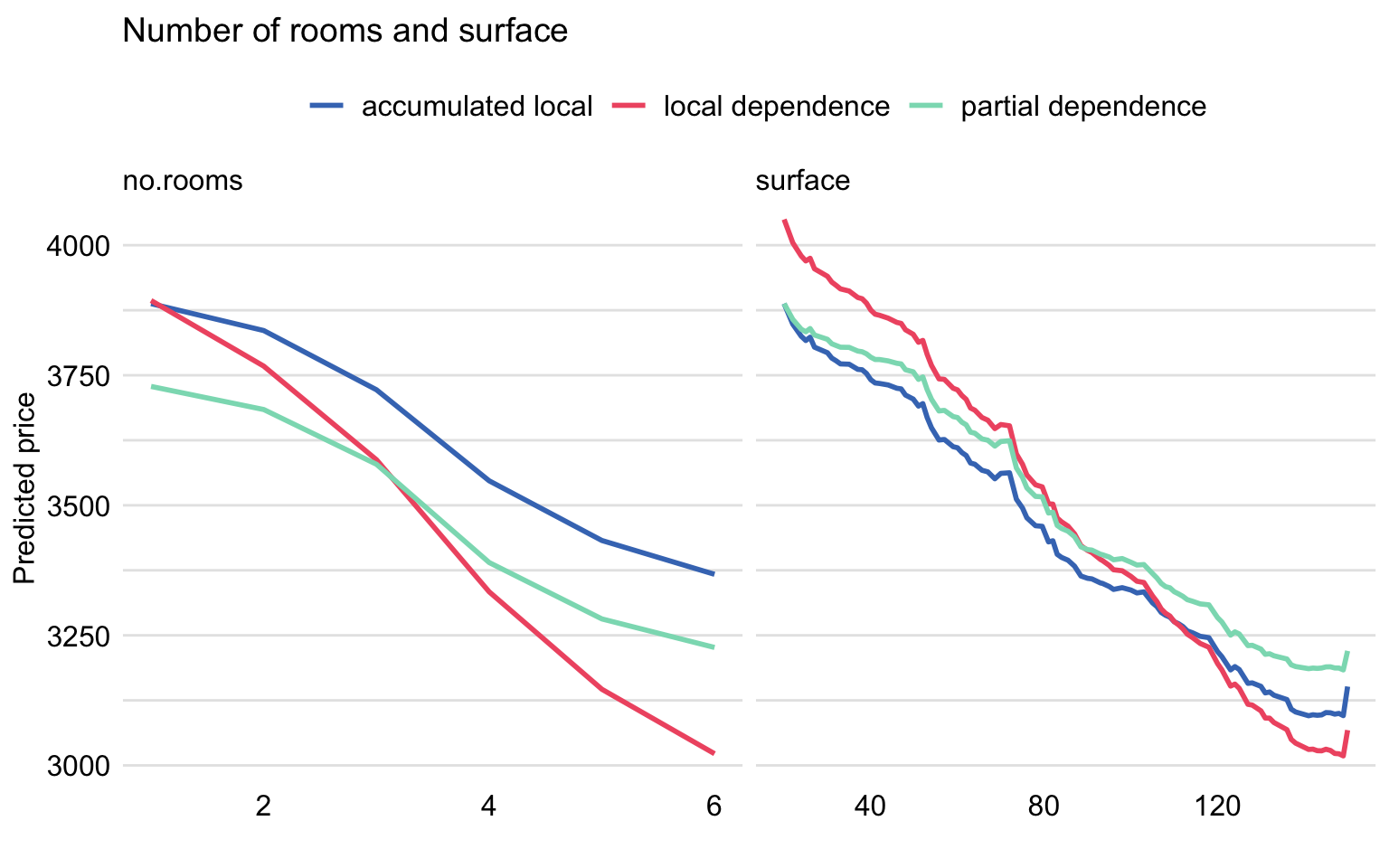
Figure 18.5: Partial-dependence, local-dependence, and accumulated-local profiles for the random forest model for the apartment-prices dataset.
18.5 Pros and cons
The LD and AL profiles, described in this chapter, are useful to summarize the influence of an explanatory variable on a model’s predictions. The profiles are constructed by using the CP profiles introduced in Chapter 10, but they differ in how the CP profiles for individual observations are summarized.
When explanatory variables are independent and there are no interactions in the model, the CP profiles are parallel and their mean, i.e., the PD profile introduced in Chapter 17, adequately summarizes them.
When the model is additive, but an explanatory variable is correlated with some other variables, neither PD nor LD profiles will properly capture the effect of the explanatory variable on the model’s predictions. However, the AL profile will provide a correct summary of the effect.
When there are interactions in the model, none of the profiles will provide a correct assessment of the effect of any explanatory variable involved in the interaction(s). This is because the profiles for the variable will also include the effect of other variables. Comparison of PD, LD, and AL profiles may help in identifying whether there are any interactions in the model and/or whether explanatory variables are correlated. When there are interactions, they may be explored by using a generalization of the PD profiles for two or more dependent variables (Apley and Zhu 2020).
18.6 Code snippets for R
In this section, we present the DALEX package for R, which covers the methods presented in this chapter. In particular, it includes wrappers for functions from the ingredients package (Biecek et al. 2019). Note that similar functionalities can be found in package ALEPlots (Apley 2018) or iml (Molnar, Bischl, and Casalicchio 2018).
For illustration purposes, we use the random forest model apartments_rf (see Section 4.5.2) for the apartment prices dataset (see Section 4.4). Recall that the goal is to predict the price per square meter of an apartment. In our illustration, we focus on two explanatory variables, surface and number of rooms.
We first load the model-object via the archivist hook, as listed in Section 4.5.6. Then we construct the explainer for the model by using the function explain() from the DALEX package (see Section 4.2.6). Note that, beforehand, we have got to load the randomForest package, as the model was fitted by using function randomForest() from this package (see Section 4.2.2) and it is important to have the corresponding predict() function available.
library("DALEX")
library("randomForest")
apartments_rf <- archivist::aread("pbiecek/models/fe7a5")
explainer_apart_rf <- DALEX::explain(model = apartments_rf,
data = apartments_test[,-1],
y = apartments_test$m2.price,
label = "Random Forest")The function that allows the computation of LD and AL profiles in the DALEX package is model_profile(). Its use and arguments were described in Section 17.6. LD profiles are calculated by specifying argument type = "conditional". In the example below, we also use the variables argument to calculate the profile only for the explanatory variables surface and no.rooms. By default, the profile is based on 100 randomly selected observations.
ld_rf <- model_profile(explainer = explainer_apart_rf,
type = "conditional",
variables = c("no.rooms", "surface"))The resulting object of class “model_profile” contains the LD profiles for both explanatory variables. By applying the plot() function to the object, we obtain separate plots of the profiles.
The resulting plot is shown in Figure 18.6. The profiles essentially correspond to those included in Figure 18.5.

Figure 18.6: Local-dependence profiles for the random forest model and explanatory variables no.rooms and surface for the apartment-prices dataset.
AL profiles are calculated by applying function model_profile() with the additional argument type = "accumulated". In the example below, we also use the variables argument to calculate the profile only for the explanatory variables surface and no.rooms.
al_rf <- model_profile(explainer = explainer_apart_rf,
type = "accumulated",
variables = c("no.rooms", "surface"))By applying the plot() function to the object, we obtain separate plots of the AL profiles for no.rooms and surface. They are presented in Figure 18.7. The profiles essentially correspond to those included in Figure 18.5.
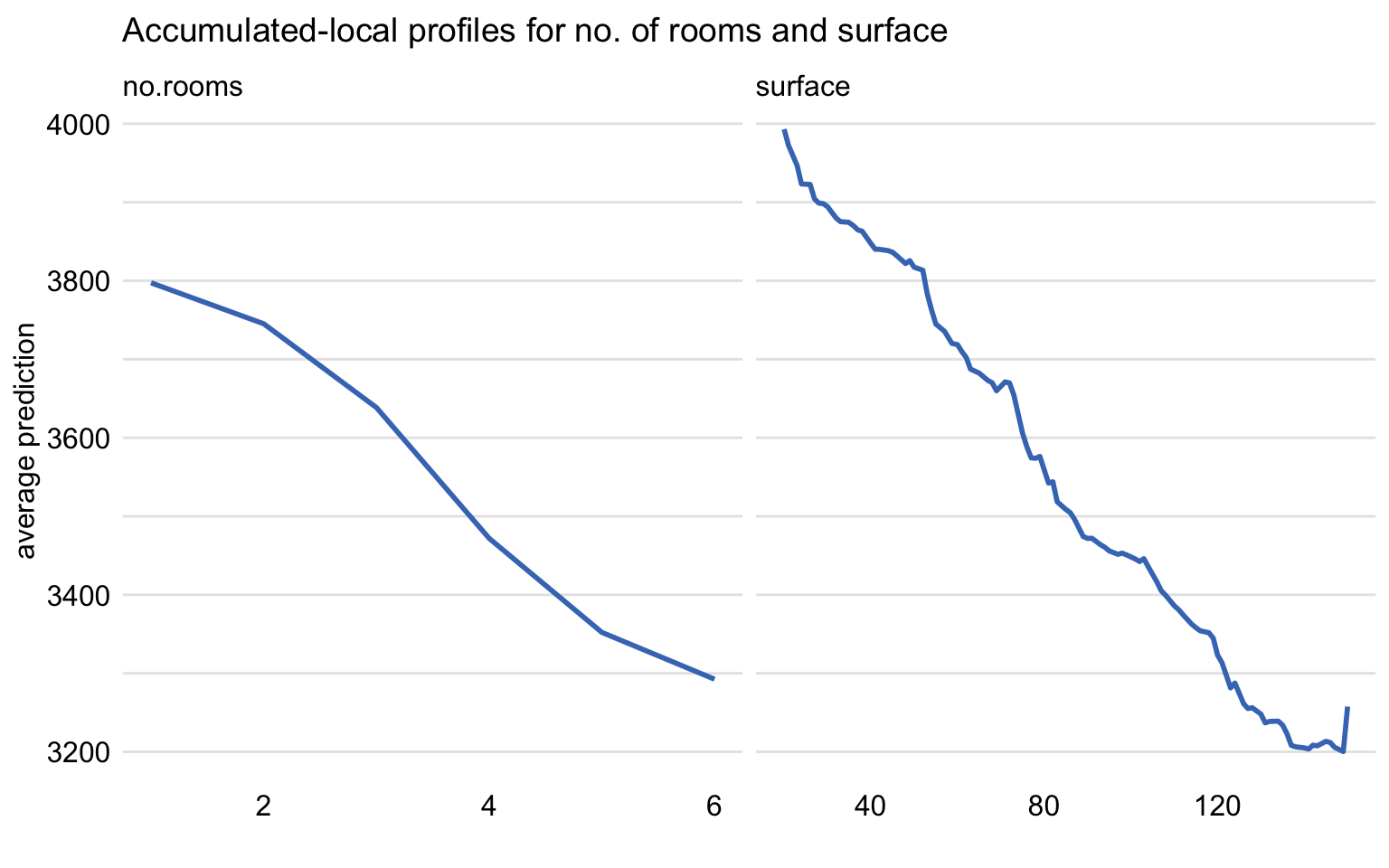
Figure 18.7: Accumulated-local profiles for the random forest model and explanatory variables no.rooms and surface for the apartment-prices dataset.
Function plot() allows including all plots in a single graph. We will show how to apply it in order to obtain Figure 18.5. Toward this end, we have got to create PD profiles first (see Section 17.6). We also modify the labels of the PD, LD, and AL profiles contained in the agr_profiles components of the “model_profile”-class objects created for the different profiles.
pd_rf <- model_profile(explainer = explainer_apart_rf,
type = "partial",
variables = c("no.rooms", "surface"))
pd_rf$agr_profiles$`_label_` = "partial dependence"
ld_rf$agr_profiles$`_label_` = "local dependence"
al_rf$agr_profiles$`_label_` = "accumulated local"Subsequently, we simply apply the plot() function to the agr_profiles components of the “model_profile”-class objects for the different profiles (see Section 17.6).
The resulting plot (not shown) is essentially the same as the one presented in Figure 18.5, with a possible difference due to the use of a different set of (randomly selected) 100 observations from the apartment-prices dataset.
18.7 Code snippets for Python
In this section, we use the dalex library for Python. The package covers all methods presented in this chapter. It is available on pip and GitHub.
For illustration purposes, we use the titanic_rf random forest model for the Titanic data developed in Section 4.3.2. Recall that the model is developed to predict the probability of survival for passengers of Titanic.
In the first step, we create an explainer-object that will provide a uniform interface for the predictive model. We use the Explainer() constructor for this purpose.
The function that allows calculations of LD profiles is model_profile(). It was already introduced in Section 17.7. By defaut, it calculates PD profiles. To obtain LD profiles, the type = 'conditional' should be used.
In the example below, we calculate the LD profile for age and fare by applying the model_profile() function to the explainer-object for the random forest model while specifying type = 'conditional'. Results are stored in the ld_rf.result field.
ld_rf = titanic_rf_exp.model_profile(type = 'conditional')
ld_rf.result['_label_'] = 'LD profiles'
ld_rf.result
Results can be visualised by using the plot() method. Note that, in the code below, we use the variables argument to display the LD profiles only for age and fare. The resulting plot is presented in Figure 18.8.
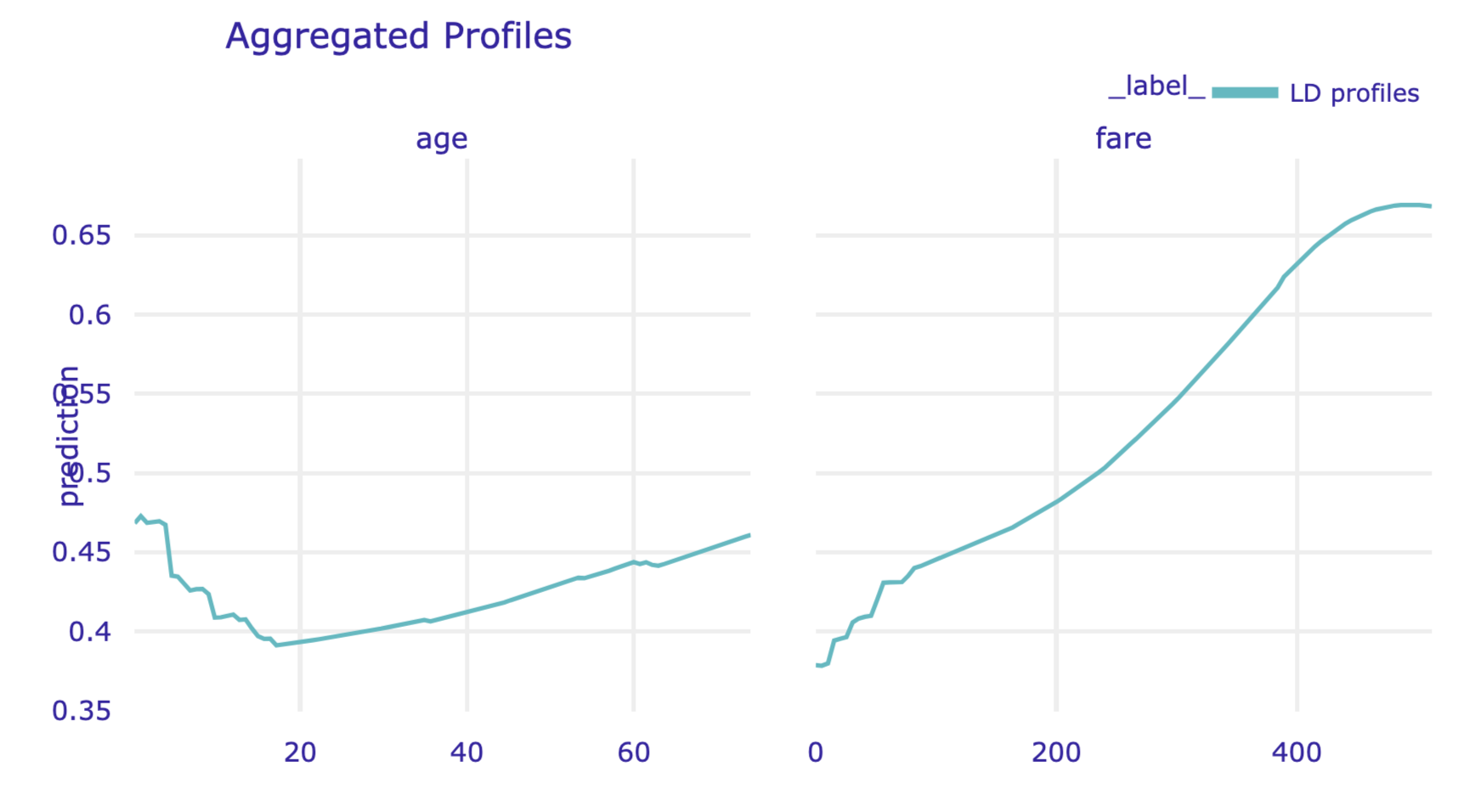
Figure 18.8: Local-dependence profiles for age and fare for the random forest model for the Titanic data, obtained by using the plot() method in Python.
In order to calculate the AL profiles for age and fare, we apply the model_profile() function with the type = 'accumulated' option.
We can plot AL and LD profiles in a single chart. Toward this end, in the code that follows, we pass the ld_rf object, which contains LD profiles, as the first argument of the plot() method of the al_rf object that includes AL profiles. We also use the variables argument to display the profiles only for age and fare. The resulting plot is presented in Figure 18.9.
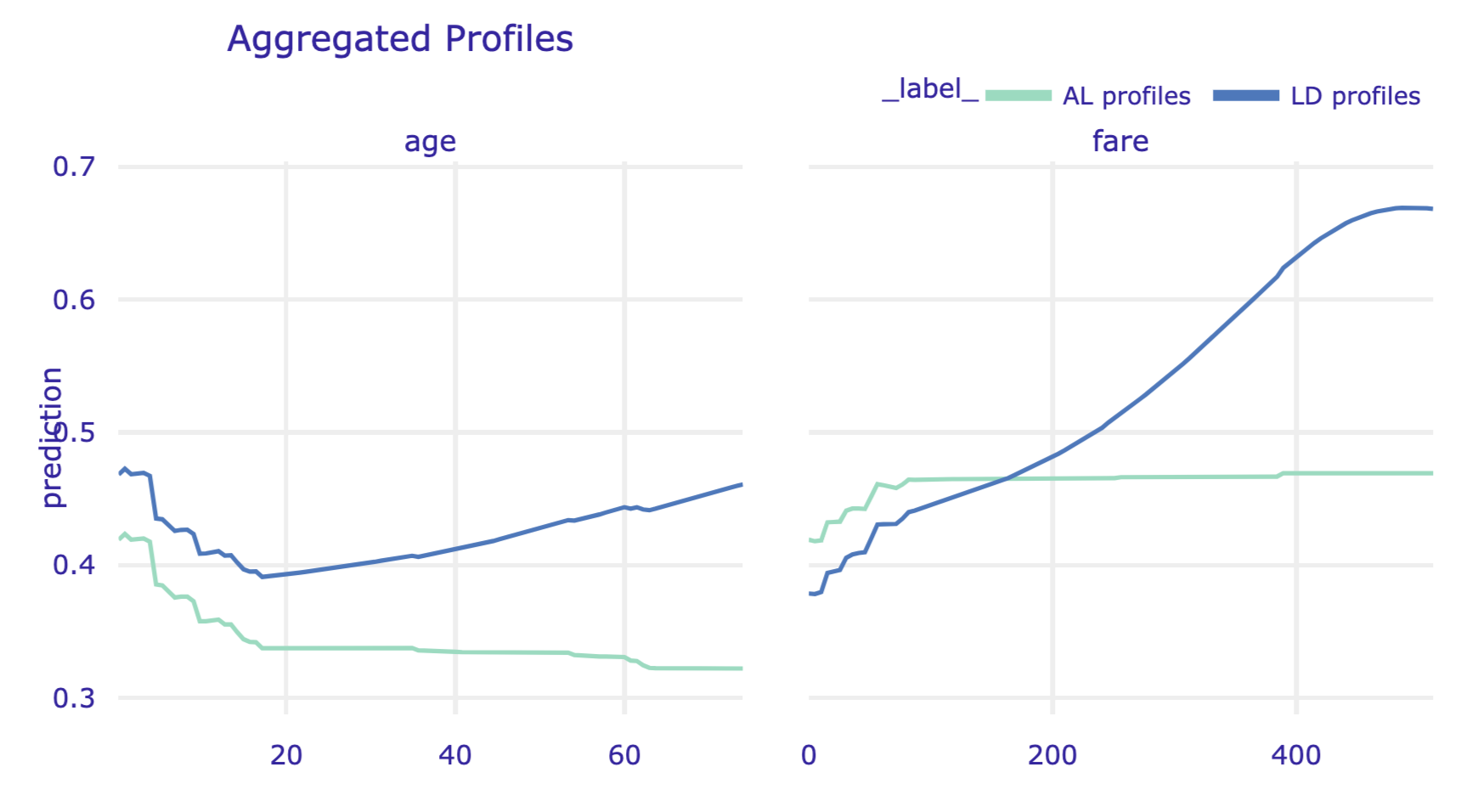
Figure 18.9: Local-dependence and accumulated-local profiles for age and fare for the random forest model for the Titanic data, obtained by using the plot() method in Python.
References
Apley, Dan. 2018. ALEPlot: Accumulated Local Effects (Ale) Plots and Partial Dependence (Pd) Plots. https://CRAN.R-project.org/package=ALEPlot.
Apley, Daniel W., and Jingyu Zhu. 2020. “Visualizing the effects of predictor variables in black box supervised learning models.” Journal of the Royal Statistical Society Series B 82 (4): 1059–86. https://doi.org/10.1111/rssb.12377.
Biecek, Przemyslaw, Hubert Baniecki, Adam Izdebski, and Katarzyna Pekala. 2019. ingredients: Effects and Importances of Model Ingredients. https://github.com/ModelOriented/ingredients.
Molnar, Christoph, Bernd Bischl, and Giuseppe Casalicchio. 2018. “iml: An R package for Interpretable Machine Learning.” Journal of Open Source Software 3 (26): 786. https://doi.org/10.21105/joss.00786.
